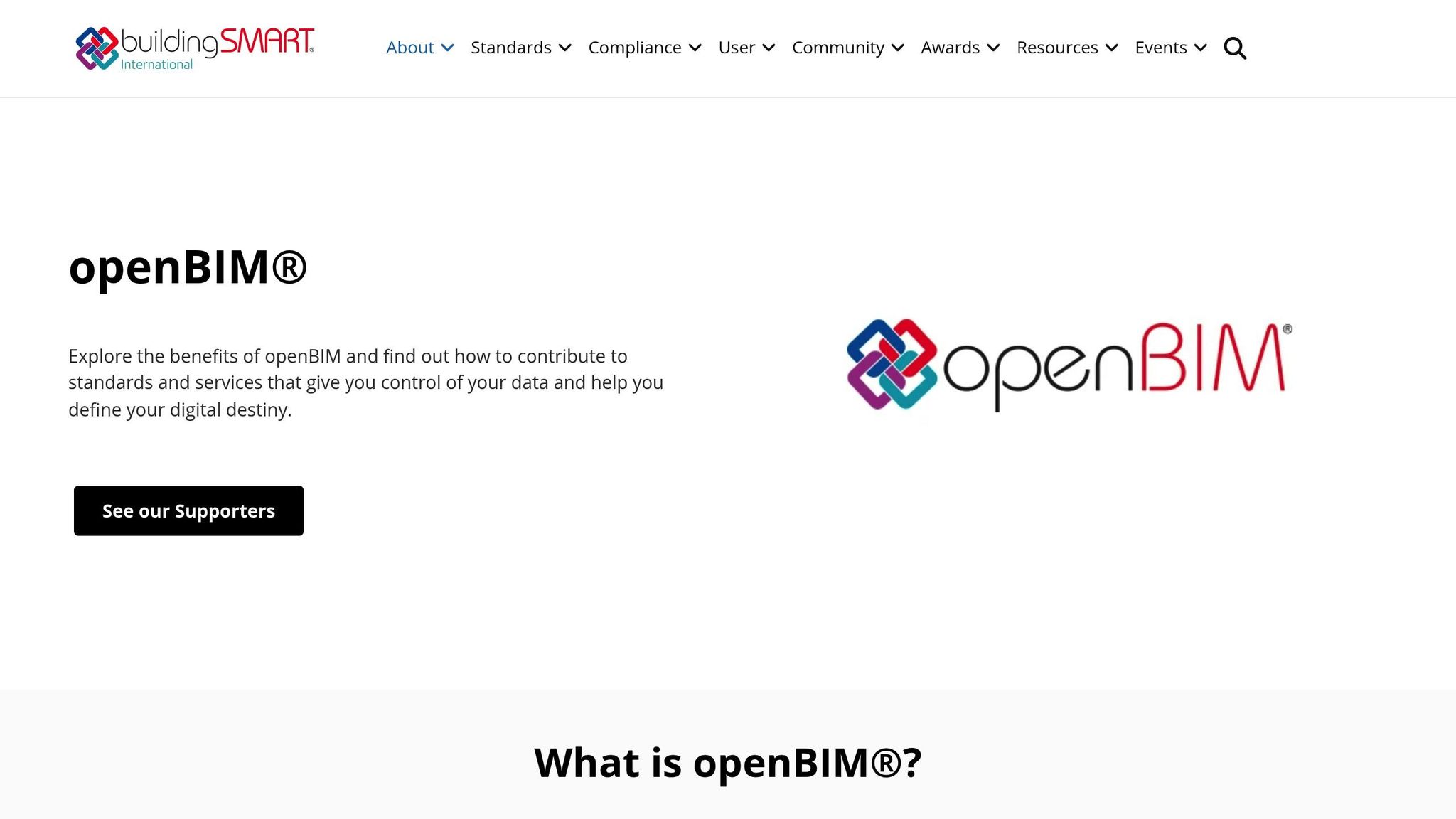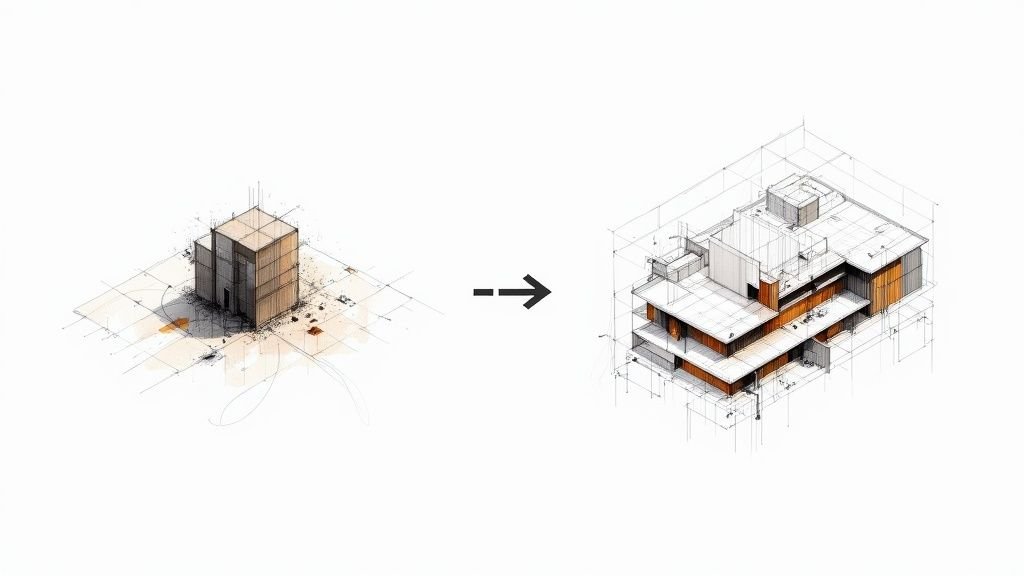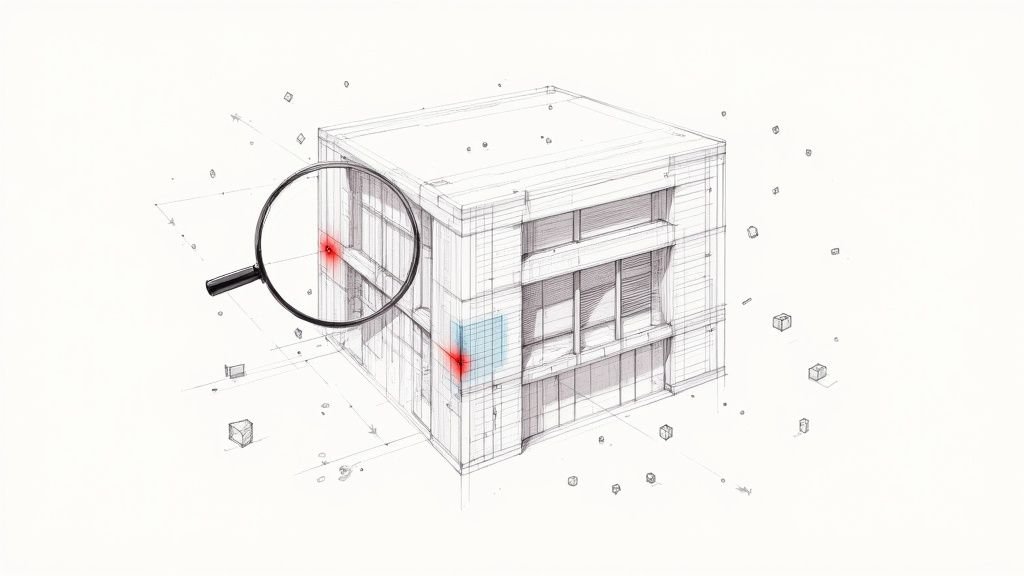IFC Standards for BIM Workflows
IFC Standards for BIM Workflows
IFC standards make BIM workflows smoother by enabling seamless data exchange between platforms. They ensure data integrity, reduce errors, and improve collaboration across all project phases, from design to facility management.
Key Takeaways:
- What is IFC? A vendor-neutral, ISO-certified standard for sharing construction data across software platforms.
- How It Helps: Ensures interoperability, reduces data loss, and supports long-term data accessibility.
- Applications: Used for clash detection, design coordination, and facility management.
- File Formats: Includes
.ifc,.ifcXML, and.ifcZIPfor different use cases. - Challenges: Complex geometries, large file sizes, and implementation hurdles may arise.
Quick Overview:
| Feature | Benefit |
|---|---|
| Interoperability | Works across multiple platforms |
| Data Integrity | Maintains accuracy during exchanges |
| Cost Savings | Reduces software dependency costs |
| Collaboration | Smooth sharing between disciplines |
IFC is essential for efficient BIM workflows, ensuring compatibility and collaboration across tools and teams.
The openBIM Workflow

IFC Technical Structure
The technical foundation of IFC plays a key role in improving interoperability and simplifying BIM workflows. Here’s a closer look at its structure and how it supports project delivery.
Data Schema and MVDs
IFC organizes building data through an object-oriented system. Each building element is treated as an entity with defined attributes and relationships. These entities are structured hierarchically, ranging from basic components like walls and doors to more complex systems such as HVAC and electrical setups.
Model View Definitions (MVDs) focus on specific subsets of the IFC schema tailored for different purposes:
- IFC Reference View: Best for geometric coordination.
- IFC Design Transfer View: Handles detailed design exchanges.
- IFC 4 Reference View: Offers coordination with reduced file sizes.
- IFC 4 Design Transfer View: Supports full model exchanges.
Types of IFC Files
IFC data can be shared using three main file formats:
| Format | Extension | Description | Best Use Case |
|---|---|---|---|
| STEP Physical File | .ifc | Standard ASCII text format | General model exchange |
| XML Representation | .ifcXML | XML-based format | Web-based applications |
| Compressed File | .ifcZIP | Compressed .ifc or .ifcXML file | Large model transfers |
The .ifc format is the most commonly used, while .ifcZIP is ideal for reducing file sizes without losing data quality.
Properties and Quantities
IFC manages building information through a structured system of properties and quantities:
Property Sets (Psets):
- Standard properties defined by buildingSMART.
- Custom properties specific to a project.
- Details on performance and materials.
Quantity Sets (QSets):
- Physical dimensions.
- Measurements for area and volume.
- Count-based information.
Properties can take on various data types:
- Single values (like numbers or text).
- Predefined lists (enumerated values).
- Ranges (bounded values).
- Complex formats (tables or arrays).
This framework ensures that essential building data is easy to access and remains consistent throughout all stages of a project, enabling smooth integration of IFC into BIM workflows.
Using IFC in BIM Projects
IFC Import/Export Guide
Getting the most out of IFC in your BIM projects starts with proper import and export settings:
Before Exporting: Prepare your model by cleaning up unused elements, checking property sets, verifying units and coordinates, and ensuring the geometry is accurate.
Configuring Export Settings:
- Choose the right MVD (Model View Definition) based on your project requirements.
- Specify which building elements to include.
- Map the necessary property sets.
- Select the file format (.ifc, .ifcXML, or .ifcZIP).
Setting up your export configurations correctly lays the groundwork for smooth IFC usage.
Quality Control Checklist:
| Stage | Action | Verification Method |
|---|---|---|
| Pre-Export | Clean up the model | Visual inspection |
| Export | Verify export settings | Review export log |
| Post-Export | Validate the file | Use IFC validator tools |
| Import | Check data completeness | Count imported elements |
IFC Applications
Accurate data exchange through IFC opens up various possibilities in BIM workflows:
Clash Detection:
- Combine models from different disciplines.
- Run automated checks for conflicts.
- Generate detailed clash reports.
- Track and resolve identified issues.
Design Coordination:
- Share model updates across teams effortlessly.
- Review and approve design changes.
- Confirm spatial requirements are met.
- Keep track of model versions.
Facility Management:
- Extract detailed asset information for operations.
- Manage maintenance schedules effectively.
- Monitor how spaces are being used.
- Update and maintain building documentation.
IFC goes beyond individual tasks, enabling collaborative workflows as part of the OpenBIM approach.
IFC and OpenBIM
Cross-Platform Integration:
- Exchange models seamlessly between different BIM tools.
- Preserve data accuracy across platforms.
- Allow teams to work on designs simultaneously.
- Facilitate real-time collaboration.
Data Management:
- Centralize all project information in one place.
- Monitor changes made to the model.
- Ensure data remains consistent throughout the project.
- Support long-term storage and retrieval of project data.
Quality Assurance:
- Validate that models meet project standards.
- Confirm data is complete and accurate.
- Ensure compliance with industry requirements.
- Keep workflows efficient and on track.
sbb-itb-0af4724
IFC Pros and Cons
IFC Benefits
IFC standards offer several advantages for BIM workflows:
Data Integrity and Accessibility
Using standardized data exchange helps maintain consistency across different platforms. It ensures long-term access to data, regardless of the software used, and allows for efficient data organization.
Cost Savings
Reduces expenses related to software licenses, training, and data conversion.
Improved Collaboration
Supports better communication between disciplines, efficient model sharing, and a unified data environment.
| Benefit Category | Impact on Workflow | Business Value |
|---|---|---|
| Interoperability | Works across multiple platforms | Lowers reliance on specific software |
| Data Management | Centralized information storage | Aids in better decision-making |
| Quality Control | Standardized validation process | Results in fewer errors and revisions |
While these benefits are clear, there are also some challenges to consider.
IFC Limitations
Technical Issues
Complex geometries may lose detail, large files can slow down performance, and some specialized parameters might not transfer correctly.
Implementation Hurdles
Setting up IFC workflows requires careful planning. Teams need training, and regular updates are necessary to ensure compatibility.
Workflow Adjustments
Exporting and importing models often calls for changes in procedures. Additional quality checks are needed, and processing times can increase with larger models.
To address these challenges, using certified software is key.
Software Certification
IFC certification ensures smooth data sharing across BIM platforms. Software providers meet strict standards to guarantee reliable workflows and consistent results.
Certification Requirements
- Must follow buildingSMART standards.
- Successful completion of certification tests is necessary.
- Frequent updates are required to keep certification valid.
Benefits of Quality Assurance
- Certified software guarantees dependable data exchange.
- Offers consistent performance across certified tools.
- Enables smooth interoperability between platforms.
Best Practices
- Keep software updated to maintain certification.
- Document workflows involving certified tools for clarity.
- Provide ongoing training for teams to ensure high standards.
The certification process ensures that data exchange between platforms and stakeholders remains consistent, reliable, and efficient.
IFC Standards: Next Steps
New Tech and IFC
The future of IFC standards is closely tied to advancements in technology. Tools like AI and digital twins are set to reshape how these standards are developed and applied. AI can simplify tasks such as model checking and classifying components within IFC workflows, making processes more efficient. Meanwhile, digital twins rely on IFC data to create virtual models of real-world assets, improving performance tracking and simulation capabilities. These technologies promise to make collaboration and data management across BIM platforms even smoother.
Conclusion
Main Points
IFC standards are essential for effective BIM workflows, facilitating smooth data sharing and collaboration across different platforms and teams. Using these standards offers clear benefits, such as better interoperability and improved project documentation.
Here are some key steps for successfully working with IFC standards:
- Standardized workflows: Set up consistent processes for exchanging IFC data.
- Quality assurance: Apply thorough model-checking practices.
- Team training: Equip staff with knowledge of IFC best practices.
- Regular updates: Keep up with the latest IFC schema versions.
BIM Heroes Services

BIM Heroes supports organizations in implementing IFC standards within their BIM workflows. Their team of BIM professionals focuses on creating and managing IFC-compliant models while adhering to international building regulations. They also offer ongoing support for long-term projects, ensuring consistency in IFC usage.
Here’s a snapshot of their services:
| Service Type | Benefits of IFC Implementation |
|---|---|
| BIM Consulting | Expert advice on integrating IFC standards |
| 3D BIM Modeling | Development of IFC-compliant models |
| CAD Documentation | Documentation aligned with IFC protocols |
| Point Cloud to BIM | Precise conversion with IFC compatibility |
BIM Heroes offers flexible engagement options, including dedicated teams, fixed-price projects, and hourly arrangements. These options allow businesses to choose the best approach to meet their IFC implementation goals, ensuring efficient resource use and streamlined project timelines.













